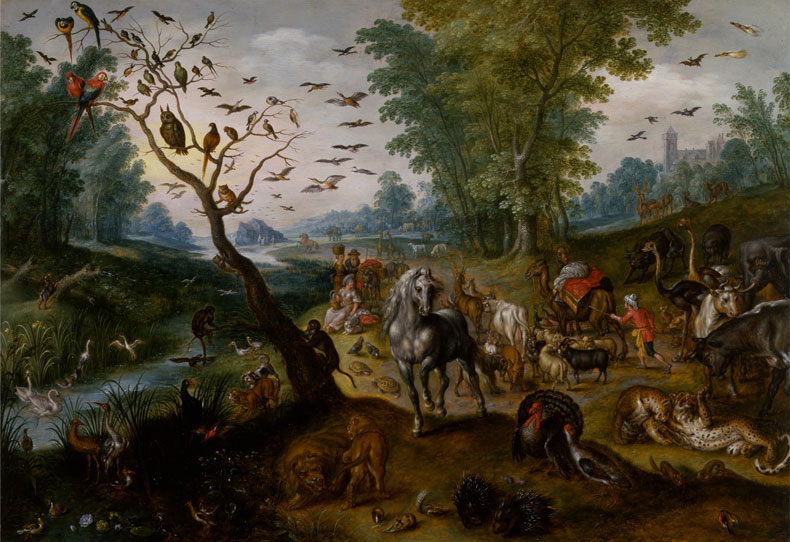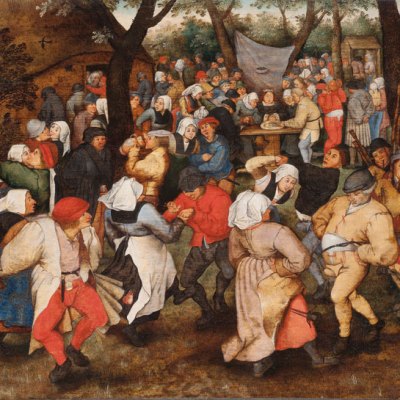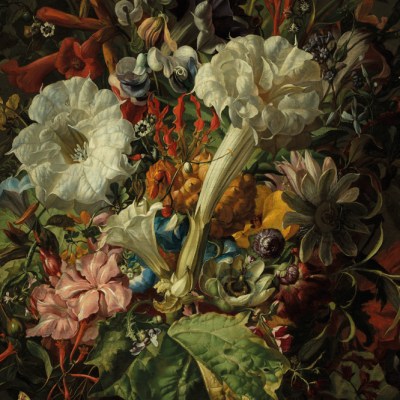From the May 2025 issue of Apollo. Preview and subscribe here.
Alexandra Libby of the National Gallery of Art in Washington, D.C., explains how Jan van Kessel I riffed on an earlier work by his grandfather, Jan Brueghel the Elder, in his teeming depiction of Noah’s ark
In all of art history, it’s hard to think of a family that accrued more prestige than the Bruegels. The dynasty began with Pieter Bruegel the Elder (c. 1525–69), best known for his landscape scenes of villagers working, hunting, playing or wreaking merry havoc; it continued with his sons Pieter Brueghel the Younger, who had a lucrative career copying his father’s work, and Jan Brueghel the Elder, who nudged Flemish painting in the direction of the baroque. Three of Jan’s children – Jan Brueghel the Younger, Ambrosius Brueghel and Anna Brueghel – were painters; his daughter Paschasia married a painter, Hieronymus van Kessel, and in 1626 gave birth to Jan van Kessel, who went on, surely to no one’s surprise, to become an artist.
The child’s artistic birthright was taken as read; he entered the regional painters’ guild, the Guild of Saint Luke, at the age of eight. Based in Antwerp, like his forebears, van Kessel quickly mastered the ‘Bruegel brand’, honing a repertoire of motifs that his grandfather had established in historical and genre scenes, which ranged from idealised landscapes to brightly coloured floral still lifes and Madonna-and-child paintings.
The number of Jan van Kessels operating in the 17th-century Netherlands would make it a ripe premise for a period farce. One of the others, also based in Antwerp, specialised in floral still lifes; another, in Amsterdam, was known for townscapes. But their painting styles were quite distinct and, by 2012, when the ‘real’ van Kessel’s catalogue raisonné was published, any remaining confusion had been ironed out.
Though he began his career by faithfully adapting works by Jan Brueghel the Elder, van Kessel soon decided to plough his own furrow. In his mid twenties he began making minutely detailed paintings of insects, which became his bread and butter: royals and other elite collectors across Europe sought his postcard-sized paintings on copper of bugs crawling, flying and landing on different objects against cream-coloured backgrounds.
But no artist’s career is a straightforward march through discrete chapters, and there were certain themes and stories van Kessel returned to a number of times between painting insects. One of these was the biblical narrative of Noah’s Ark. Van Kessel painted this scene – Noah’s Family Assembling Animals before the Ark – at least three times in his career. The version pictured here is from c. 1660 and is owned by the Walters Art Museum. Each rendering is slightly different from the others in the placement of the animals, the degree of chiaroscuro and the architecture in the background. All of them, however, are based on an original painting by Jan Brueghel the Elder: The Entry of the Animals into Noah’s Ark (1613), currently held by the Getty Museum in Los Angeles.
Noah’s Family Assembling Animals before the Ark (c. 1660; detail), Jan van Kessel I. Walters Art Museum, Baltimore

For its viewers, much of the appeal of Noah’s Family Assembling Animals lay in its exoticism. There are scarlet macaws, African grey parrots, ostriches, leopards and all manner of other creatures that were not part of the visual vocabulary of the time. In this regard it wasn’t dissimilar to van Kessel’s floral still lifes: the kinds of flowers he was depicting were extraordinarily expensive luxury goods, and paintings of them were like fantasias. Peonies and roses, which did not bloom at the same time, were positioned alongside each other in a bouquet.
As well as being designed to demonstrate the artist’s intelligence and talent, Noah’s Family Assembling Animals linked van Kessel to his illustrious grandfather. It’s not clear who commissioned this painting, but for whoever it was, it was a kind of proxy for the original, which Brueghel had made for Archduke Albert of Austria and his wife, Isabella of Spain. Owning van Kessel’s copy was as close as some people could get to owning a piece of the Habsburg collection – and a famous piece at that.
But this was no rote imitation. Van Kessel displays some inventiveness, shifting certain pairings of animals to give them each a bit more room. He has moved the turtles, for example, backwards into the middle ground so that the lions, the turkeys and the horse in the centre have a little more space, and he’s brought the giraffes closer to the middle ground. The cluster of trees has been pushed back, which extends the landscape and gives the composition more depth, allowing viewers to better contemplate each of the animals. In Brueghel’s painting, the animals flood the scene, though there is little intimation of a literal deluge: the sunshine and blue sky stand in contrast to van Kessel’s more inclement weather. (Brueghel was a pioneer of the ‘paradise landscape’, a genre that featured idealised depictions of scenes from Genesis.)
By the time van Kessel was painting his version, the Habsburgs had ruled the Netherlands for nearly 200 years. They had also been benefiting from Portuguese trade, giving them access to luxury goods – and creatures – from all sorts of places, from Morocco to Persia, Ethiopia to India. Albert and Isabella had a huge menagerie, with monkeys, camels, ostriches, macaws and even crustaceans, and they treasured their pets – not least Albert’s dapple-grey stallion, which the archduke had imported from Spain. Rubens and other artists had painted this magnificent creature; as horses go, he was something of a celebrity, so it’s unsurprising that he has pride of place in the centre of van Kessel’s landscape.
Noah’s Family Assembling Animals before the Ark (c. 1660; detail), Jan van Kessel I. Walters Art Museum, Baltimore

It was an unusual decision on Brueghel’s part to push Noah so far into the background, but not unprecedented: in Michelangelo’s Deluge (1508–12), on the ceiling of the Sistine Chapel, the drowning sinners are in the foreground and the ark is far behind them. Not long afterwards, Flemish paintings of biblical stories began to resemble early versions of Where’s Wally? In Pieter Aertsen’s A Meat Stall with the Holy Family Giving Alms (1551), the Virgin Mary is just about visible giving alms to the poor in the background, while the foreground is heaving with meat for sale; in Saint Jerome in the Desert (1555–56), a print after a design by Pieter Bruegel the Elder, the saint is hunched over a book towards the right of the canvas, dwarfed by the landscape. Treating the biblical narratives as secondary was characteristic of Flemish painting at the time.
As if to emphasise this, the identity of the human characters in van Kessel’s painting is unclear. The group in the middle of the painting would seem to be Noah and family, but it’s not obvious: the older man and his wife are accompanied by a young woman, whereas Noah had three sons. As for the turbaned man poking the dromedary, that seems to have been artistic licence on Brueghel’s part – despite the man’s Caucasian appearance, it is likely meant to be someone from the same part of the world as the dromedaries.
For a 17th-century viewer, almost all of these animals would have been unusual – particularly the turkey, which had arrived from North America on a Habsburg ship. This isn’t to say that no one had ever heard of these creatures. Since the 15th century, a tremendous number of books had been published about animals; natural historians and artists would send pictures and descriptions to each other, and publishers would create images based on what they’d seen or been told. (There was also a disconcerting amount written about what these exotic animals tasted like.) But in the 17th century more and more people could see these animals for themselves. When Brueghel made The Entry of the Animals into Noah’s Ark, his lions were observed directly from real ones. (Rubens, Brueghel’s friend and collaborator, also claimed to paint lions entirely from life, though it’s understood that they were also inspired by some bronzes he saw in Padua.)
Noah’s Family Assembling Animals before the Ark (c. 1660), Jan van Kessel I. Walters Art Museum, Baltimore

With all these animals arriving on Netherlandish shores, Flemish depictions of them became more informed – albeit still, in some cases, rather goofy. Look at the giraffes in van Kessel’s painting: they are scarcely bigger than the dogs standing behind them. This is in line with depictions by Conrad Gessner (1516–65), a naturalist who clearly failed to grasp the actual size of giraffes. (Intriguingly, the giraffes are more accurately proportioned in Brueghel’s original than in van Kessel’s version.) Van Kessel also falters a little in his rendering of the lions: it’s clear that he was more comfortable working at a smaller scale. There is much more finesse in his renderings of the African crested porcupines in the foreground, and the guinea pigs, which had come from South America. The ostriches are also delightful to behold, not so much for any particular painterly technique as for their highly entertaining facial expressions.
All these animals had been extracted from their natural habitat; it wasn’t a great time to be an ostrich in Brussels or Antwerp. It was, however, a great time to be a talented scion of the Bruegel family. When he completed this painting, van Kessel was in his pomp – and had another 20 years left in him. Antwerp may have been in decline as a major European capital, but there were still enough merchant ships, wealthy patrons and publishers for the city’s visual culture to be in robust health. On one level, Noah’s Family Assembling Animals Before the Ark is a biblical story; on another it’s a story of dynastic succession. But the story it communicates most strongly is one it may never have intended to: a tale of imperial expansion, mercantile might and a world somehow growing smaller and larger at the same time.
As told to Arjun Sajip.
Alexandra Libby is senior administrator for collections and initiatives and associate curator of northern baroque paintings at the National Gallery of Art in Washington, D.C.
‘Little Beasts: Art, Wonder, and the Natural World’ is at the National Gallery of Art, Washington, D.C., from 18 May–2 November (nga.gov).
From the May 2025 issue of Apollo. Preview and subscribe here.


